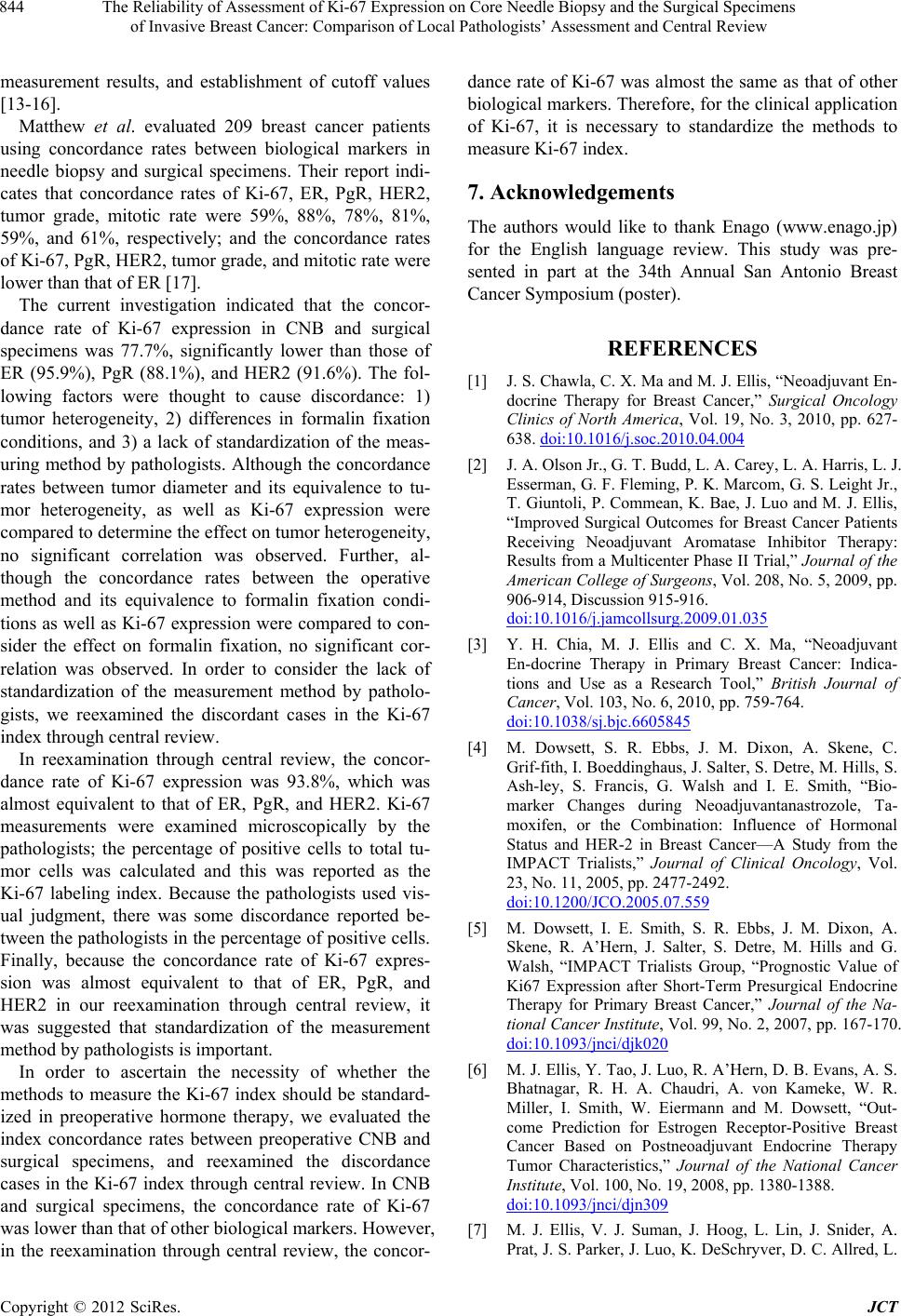
The Reliability of Assessment of Ki-67 Expression on Core Needle Biopsy and the Surgical Specimens
of Invasive Breast Cancer: Comparison of Local Pathologists’ Assessment and Central Review
844
measurement results, and establishment of cutoff values
[13-16].
Matthew et al. evaluated 209 breast cancer patients
using concordance rates between biological markers in
needle biopsy and surgical specimens. Their report indi-
cates that concordance rates of Ki-67, ER, PgR, HER2,
tumor grade, mitotic rate were 59%, 88%, 78%, 81%,
59%, and 61%, respectively; and the concordance rates
of Ki-67, PgR, HER2, tumor grade, and mitotic rate were
lower than that of ER [17].
The current investigation indicated that the concor-
dance rate of Ki-67 expression in CNB and surgical
specimens was 77.7%, significantly lower than those of
ER (95.9%), PgR (88.1%), and HER2 (91.6%). The fol-
lowing factors were thought to cause discordance: 1)
tumor heterogeneity, 2) differences in formalin fixation
conditions, and 3) a lack of standardization of the meas-
uring method by pathologists. Although the concordance
rates between tumor diameter and its equivalence to tu-
mor heterogeneity, as well as Ki-67 expression were
compared to determine the effect on tumor heterogeneity,
no significant correlation was observed. Further, al-
though the concordance rates between the operative
method and its equivalence to formalin fixation condi-
tions as well as Ki-67 expression were compared to con-
sider the effect on formalin fixation, no significant cor-
relation was observed. In order to consider the lack of
standardization of the measurement method by patholo-
gists, we reexamined the discordant cases in the Ki-67
index through central review.
In reexamination through central review, the concor-
dance rate of Ki-67 expression was 93.8%, which was
almost equivalent to that of ER, PgR, and HER2. Ki-67
measurements were examined microscopically by the
pathologists; the percentage of positive cells to total tu-
mor cells was calculated and this was reported as the
Ki-67 labeling index. Because the pathologists used vis-
ual judgment, there was some discordance reported be-
tween the pathologists in the percentage of positive cells.
Finally, because the concordance rate of Ki-67 expres-
sion was almost equivalent to that of ER, PgR, and
HER2 in our reexamination through central review, it
was suggested that standardization of the measurement
method by pathologists is important.
In order to ascertain the necessity of whether the
methods to measure the Ki-67 index should be standard-
ized in preoperative hormone therapy, we evaluated the
index concordance rates between preoperative CNB and
surgical specimens, and reexamined the discordance
cases in the Ki-67 index through central review. In CNB
and surgical specimens, the concordance rate of Ki-67
was lower than that of other biological markers. However,
in the reexamination through central review, the concor-
dance rate of Ki-67 was almost the same as that of other
biological markers. Therefore, for the clinical application
of Ki-67, it is necessary to standardize the methods to
measure Ki-67 index.
7. Acknowledgements
The authors would like to thank Enago (www.enago.jp)
for the English language review. This study was pre-
sented in part at the 34th Annual San Antonio Breast
Cancer Symposium (poster).
REFERENCES
[1] J. S. Chawla, C. X. Ma and M. J. Ellis, “Neoadjuvant En-
docrine Therapy for Breast Cancer,” Surgical Oncology
Clinics of North America, Vol. 19, No. 3, 2010, pp. 627-
638. doi:10.1016/j.soc.2010.04.004
[2] J. A. Olson Jr., G. T. Budd, L. A. Carey, L. A. Harris, L. J.
Esserman, G. F. Fleming, P. K. Marcom, G. S. Leight Jr.,
T. Giuntoli, P. Commean, K. Bae, J. Luo and M. J. Ellis,
“Improved Surgical Outcomes for Breast Cancer Patients
Receiving Neoadjuvant Aromatase Inhibitor Therapy:
Results from a Multicenter Phase II Trial,” Journal of the
American College of Surgeons, Vol. 208, No. 5, 2009, pp.
906-914, Discussion 915-916.
doi:10.1016/j.jamcollsurg.2009.01.035
[3] Y. H. Chia, M. J. Ellis and C. X. Ma, “Neoadjuvant
En-docrine Therapy in Primary Breast Cancer: Indica-
tions and Use as a Research Tool,” British Journal of
Cancer, Vol. 103, No. 6, 2010, pp. 759-764.
doi:10.1038/sj.bjc.6605845
[4] M. Dowsett, S. R. Ebbs, J. M. Dixon, A. Skene, C.
Grif-fith, I. Boeddinghaus, J. Salter, S. Detre, M. Hills, S.
Ash-ley, S. Francis, G. Walsh and I. E. Smith, “Bio-
marker Changes during Neoadjuvantanastrozole, Ta-
moxifen, or the Combination: Influence of Hormonal
Status and HER-2 in Breast Cancer—A Study from the
IMPACT Trialists,” Journal of Clinical Oncology, Vol.
23, No. 11, 2005, pp. 2477-2492.
doi:10.1200/JCO.2005.07.559
[5] M. Dowsett, I. E. Smith, S. R. Ebbs, J. M. Dixon, A.
Skene, R. A’Hern, J. Salter, S. Detre, M. Hills and G.
Walsh, “IMPACT Trialists Group, “Prognostic Value of
Ki67 Expression after Short-Term Presurgical Endocrine
Therapy for Primary Breast Cancer,” Journal of the Na-
tional Cancer Institute, Vol. 99, No. 2, 2007, pp. 167-170.
doi:10.1093/jnci/djk020
[6] M. J. Ellis, Y. Tao, J. Luo, R. A’Hern, D. B. Evans, A. S.
Bhatnagar, R. H. A. Chaudri, A. von Kameke, W. R.
Miller, I. Smith, W. Eiermann and M. Dowsett, “Out-
come Prediction for Estrogen Receptor-Positive Breast
Cancer Based on Postneoadjuvant Endocrine Therapy
Tumor Characteristics,” Journal of the National Cancer
Institute, Vol. 100, No. 19, 2008, pp. 1380-1388.
doi:10.1093/jnci/djn309
[7] M. J. Ellis, V. J. Suman, J. Hoog, L. Lin, J. Snider, A.
Prat, J. S. Parker, J. Luo, K. DeSchryver, D. C. Allred, L.
Copyright © 2012 SciRes. JCT